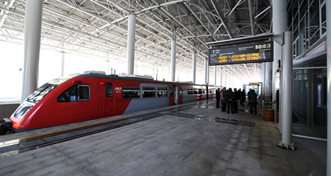Russian ideas inspire California’s Hyperloop plan
The project for a near-vacuum, high-speed, elevated tunnel linking Los Angeles and San Francisco has been presented in the U.S. and has sparked media attention worldwide. Meanwhile, Russian scientists in Tomsk deny that U.S. scientists had to invent the project from scratch, as ideas voiced and explored by a Tomsk scientist in the early 20th century already existed.
The Hyperloop — a project for a 375-mile-long tunnel between Los Angeles and San Francisco sketched out by Elon Musk, a businessman from the U.S. — is actually based on original designs by Tomsk University researcher Boris Weinberg that go back almost a hundred years.
Related:
New high-speed rail to link Moscow and Kazan
High-speed railroad could connect Moscow, Krasnoyarsk in future
In his work entitled “Motion without Friction”published in 1914, Weinberg talked about levitating cars running on electromagnetic propulsion inside a copper tube. In Weinberg's mind, the cars would run inside an evacuated copper tube held up in the air by electromagnets and steering clear of its walls.
Sources at Tomsk University explained that the project was hardly conceivable in the early 20th century and could not be put into practice because of the costs involved.
The “Motion without Friction” paper sparked a lot of discussion in the U.S. and even prompted a documentary about the “Siberian magnetoplan.”
For two years running, Weinberg tried to create a mockup laboratory model of the railway he had come up with. “He experimented with a 10kg wagon shaped like a tube, with front and rear wheels running inside a 32cm-diameter copper pipe looped into a circle measuring 6.5m in diameter.
In this environment, the car was able to reach a speed of up to 6km per hour. The author was positive that a 3km long magnetic coil at the departure station would make a speed range of 800–1000 km per hour [500–620 miles per hour] an easily achievable target,” a review of “Motion without Friction”reads.
In the U.S. project, special magnetic accelerators would be used in the tunnel to propel or slow down the capsules. It is presumed that the electromagnetic field and an air cushion beneath the shuttle would make the motion smooth.
The tube would be powered by solar batteries installed on the roof of the tunnel. According to preliminary estimates, the journey, at a speed of 760 miles per hour, would only take 30 minutes and cost roughly $20 per ride on this “train of the future.” Preliminary costs are put at approximately $6 billion.
“There is also a very serious downside. Basically, this is that people are wary of anything new. It would be a real challenge to convince them to use the train for the first time, because people are afraid for their lives,” Ivan Stupachenko, executive editor of The RZD-Partner Internationalmagazine, said. This could be yet another reason why Weinberg's work was not actually appreciated at the time.
Boris Weinberg was a professor at Tomsk Technological Institute between 1909 and 1924, earning the first doctorate degree in physics in Siberia. Weinberg set up Russia's biggest school in solid-state physics and authored physics textbooks used by many generations of students to come.
All rights reserved by Rossiyskaya Gazeta.
Subscribe
to our newsletter!
Get the week's best stories straight to your inbox
